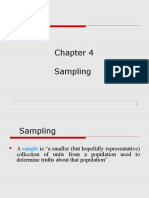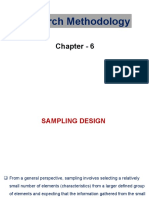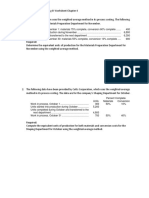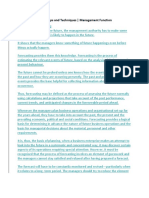TOPIC 6: SAMPLING AND SAMPLING TECHNIQUES
Introduction
The method section of a research study describes the procedures that are to be followed in
conducting the study. The techniques of obtaining data are developed.
Population: is a complete set of individuals, cases or objects with some observable characteristics.
A census is a count of all the elements in a population.
Sample
A sample is a subset of a particular population. The target population is that population to which
a researcher wants to generalize the results of the study. There must be a rationale for defining and
identifying the accessible population from the target population.
Sampling;
It’s the process of selecting a sample from a population.
The Sample Design
It refers to the techniques or the procedure the researcher would adopt in selecting items for the
sample.
Factors to consider in developing a sample design
1. Type of universe; finite or infinite
2. Sampling unit; geographic: state, district or village, construction unit: house, flat. Social
unit: family, club, school or individual.
3. Source list: sampling frame- contains all the names of all items of a universe. The list
should be comprehensive, correct, reliable and appropriate.
4. The size of the sample should be efficient, representative, reliable and flexible.
5. Parameters of interest
6. Budgetary constraint
7. Sampling procedure.
Criteria for selecting a sampling procedure
Two costs are involved in a sampling analysis i.e. the cost of collecting the data and the cost of an
incorrect inference resulting from the data. Two causes of incorrect inferences are systematic bias
and sampling error. A systematic bias result from errors in the sampling procedures and it cannot
be reduced or eliminated by increasing the sample size. Systematic bias is the result of the
following factors:-
Inappropriate sampling frame
Defective measuring device
Non-respondents
Indeterminacy principle – individuals act differently when kept under observation.
Natural bias in reporting data
Sampling errors are the random variations in the sample estimates around a true population
parameter. It decreases with the increase in the size of the sample and it happens to be of a smaller
Page 1 of 6
�magnitude in case of a homogenous population. While selecting a sampling procedure, the
researcher must ensure that the procedure causes a relatively small sampling error and helps to
control the systematic bias in a better way.
Steps in Sampling Design
Identification of the: -
Relevant population
Type of universe i.e. finite or infinite
Parameters of interest
Sampling frame
Type of sample i.e. probabilistic or non-probabilistic
Size of the sample needed
Characteristics of a good sample design
Must result in a truly representative sample
Must result in a small sampling error
Must be viable in the context of funds available for the research study
Must ensure that systematic bias is controlled in a better way
Must be such that the results of the sample study can be applied in general for the universe
with a reasonable level of confidence.
Reasons for sampling
Cost
Time: Greater speed of data collection
Destructive nature of certain tests
Greater accuracy of results
Physical impossibility of checking all items in the population.
Availability of population elements.
Characteristics of a good sample
Accuracy: It’s the degree to which bias is absent from the sample. An unbiased sample is the one
in which the under estimators and the over estimators are balanced among the members of the
sample.
Precision of estimate: Precision is measured by the standard error of estimate a type of standard
deviation measurement. The smaller the error of estimate, the higher is the preciseness of the
sample.
Factors that influence the sample size
Dispersion / variance: The greater the dispersion or variance within the population, the
larger the sample must be to provide estimation precision.
Precision of the estimate: the greater the desired precision of the estimate, the larger the
sample must be.
Interval range: The narrower the interval range, the larger the sample must be.
Confidence level: The higher the confidence level in the estimate, the larger the sample
must be.
Page 2 of 6
� Number of subgroups: The greater the number of subgroups of interest within a sample,
the greater the sample size must be, as each subgroup must meet minimum sample size
requirements.
Ways of determining the sample size:
If the target population is greater than 10,000 the following formula is used to determine the sample
size;
If the target population is less than 10,000 the following formula is used to determine the sample
size;
Sampling procedures:
There are two major ways of selecting samples;
Probability sampling methods
Non - Probability sampling methods
Probability Sampling Methods Samples are selected in such a way that each item or person in
the population has a known (Nonzero) likelihood of being included in the sample.
Types of Probability sampling methods
1. Simple Random Sampling: A sample is selected so that each item or person in the population
has the same chance of being included.
Advantages
Easy to implement with automatic dialing and with computerized voice response systems.
Disadvantages
Requires a listing of population elements.
Takes more time to implement
Page 3 of 6
� Uses larger sample sizes
Produces larger errors
Expensive
2. Systematic Random Sampling:
The items or individuals of the population are arranged in some manner. A random starting point
is selected and then every kth member of the population is selected for the sample.
Advantages
Simple to design
Easier to use than the simple random.
Easy to determine sampling distribution of mean or proportion.
Less expensive than simple random.
Disadvantages
Periodicity within the population may skew the sample and results.
If the population list has a monotonic trend, a biased estimate will result based on the start
point.
3. Stratified Random Sampling:
A population is divided into subgroups called strata and a sample is selected from each stratum.
After the population is divided into strata, either a proportional or a non-proportional sample can
be selected. In a proportional sample, the number of items in each stratum is in the same proportion
as in the population while in a non-proportional sample, the number of items chosen in each
stratum is disproportionate to the respective numbers in the population.
Advantages
Researcher controls sample size in strata
Increased statistical efficiency
Provides data to represent and analyze subgroups
Enables use of 0different methods in strata
Disadvantages
Increased error will result if subgroups are selected at different rates
Expensive especially if strata on the population have to be created.
4. Cluster Sampling:
The population is divided into internally heterogeneous subgroups and some are randomly selected
for further study. It is used when it is not possible to obtain a sampling frame because the
population is either very large or scattered over a large geographical area. A multi-stage cluster
sampling method can also be used.
Advantages
Provides an unbiased estimate of population parameters if properly done.
Economically more efficient than simple random.
Lowest cost per sample, especially with geographic clusters.
Easy to do without a population list.
Disadvantages
More error (Lower statistical efficiency) due to subgroups being homogeneous rather the
heterogeneous.
Non - Probability Sampling Methods
It is used when a researcher is not interested in selecting a sample that is representative of the
population.
Page 4 of 6
�1. Convenience or Accidental Sampling
It involves selecting cases or units of observation as they become available to the researcher e.g.
asking a question to the radio listeners, roommates or neighbors.
2. Purposive Sampling or Judgmental Sampling
It allows the researcher to use cases that have the required information with respect to the
objectives of his or her study e.g. educational level, age group, religious sect etc.
3. Quota Sampling
The researcher purposively selects subjects to fit the quotas identified e.g.
Gender: Male or Female.
Class Level: Graduate or Undergraduate
School: Humanities, Science or human resource development.
Religion: Muslim, Protestant, catholic, Jewish.
Fraternal affiliation: member or nonmember.
Social economic class: Upper, middle or lower.
Advantage
Widely used by pollsters, marketers and other researchers.
Disadvantages
It gives no assurance that the sample is representative of the variables being studied.
The data used to provide controls may be outdated or inaccurate.
There is a practical limit on the number of simultaneous controls that can be applied to
ensure precision.
Since the choice of subjects is left to field workers, they may choose only friendly looking
people.
4. Snow ball sampling
It is used when the population that possesses the characteristics under study is not well known and
can be best located through referral networks. Initial subjects are identified who in turn identify
others. Commonly used in drug cultures, teenage gang activities, Mungiki sect, insider trading,
Mau Mau etc.
Sampling error
It’s the difference between a sample statistic and its corresponding population parameter. The
sampling distribution of the sample means is a probability distribution of possible sample means
of a given sample size.
The central limit theorem
If samples of a particular size are selected from any population, the sampling distribution of the
sample means is approximately a normal distribution. The approximation improves with larger
samples.
Point estimates and confidence intervals
Point estimate is the value computed from sample information that is used to estimate the
population parameter.
Page 5 of 6
� Confidence interval is a range of values constructed from sample data so the parameter
occurs within that range at a specified probability (level of confidence).
The standard error of the mean (σx)
The standard error is a measure of the variability of the sampling distribution of the sample mean.
Its size is affected by
Standard deviation: the larger the standard deviation, the larger the standard error.
Sample size: as the sample size increases, the standard error decreases.
LECTURE EXERCISES
1. Differentiate between a sample and the population
2. Discuss the reasons for sampling.
3. Explain the factors that affect the size of a sample
4. Explain the probabilistic and non-probabilistic sampling techniques.
5. Explain the conditions under which non-probabilistic techniques may be preferred to the
probabilistic sampling techniques.
Page 6 of 6






















































































